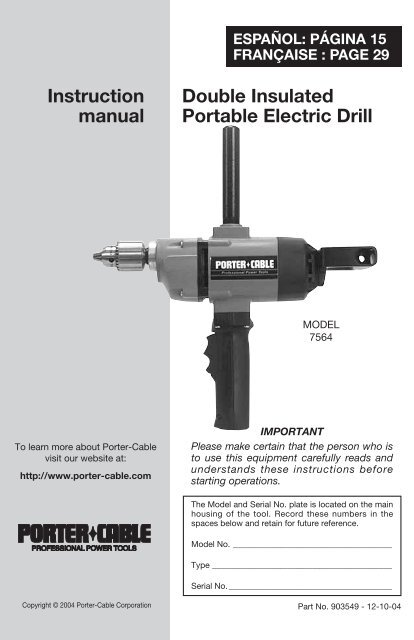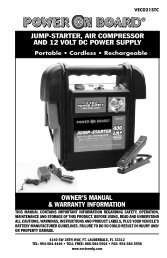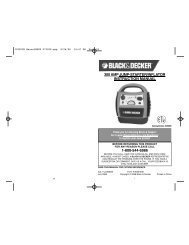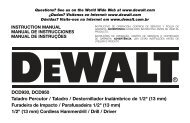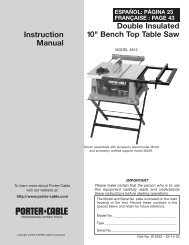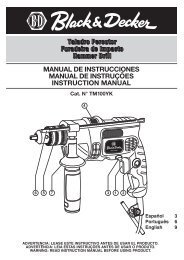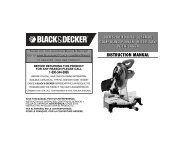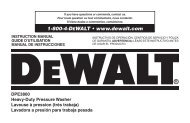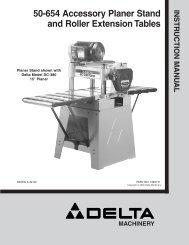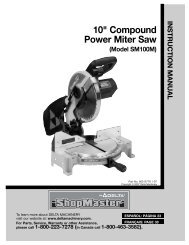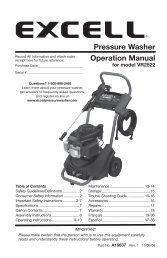Double Insulated Portable Electric Drill Instruction manual
Double Insulated Portable Electric Drill Instruction manual
Double Insulated Portable Electric Drill Instruction manual
You also want an ePaper? Increase the reach of your titles
YUMPU automatically turns print PDFs into web optimized ePapers that Google loves.
ESPAÑOL: PÁGINA 15FRANÇAISE : PAGE 29<strong>Instruction</strong><strong>manual</strong><strong>Double</strong> <strong>Insulated</strong><strong>Portable</strong> <strong>Electric</strong> <strong>Drill</strong>MODEL7564To learn more about Porter-Cablevisit our website at:http://www.porter-cable.comIMPORTANTPlease make certain that the person who isto use this equipment carefully reads andunderstands these instructions beforestarting operations.The Model and Serial No. plate is located on the mainhousing of the tool. Record these numbers in thespaces below and retain for future reference.Model No. ______________________________________Type ___________________________________________Serial No. _______________________________________Copyright © 2004 Porter-Cable CorporationPart No. 903549 - 12-10-04
SAFETY GUIDELINES - DEFINITIONSIt is important for you to read and understand this <strong>manual</strong>. Theinformation it contains relates to protecting YOUR SAFETY andPREVENTING PROBLEMS. The symbols below are used to helpyou recognize this information.indicates an imminently hazardous situation which, if notavoided, will result in death or serious injury.indicates a potentially hazardous situation which, if notavoided,could result in death or serious injury.indicates a potentially hazardous situation which, if notavoided,may result in minor or moderate injury.used without the safety alert symbol indicates potentiallyhazardous situation which, if not avoided, may result inproperty damage.CALIFORNIA PROPOSITION 65Some dust created by power sanding, sawing, grinding, drilling,and other construction activities contains chemicals known (to theState of California) to cause cancer, birth defects or other reproductive harm. Someexamples of these chemicals are:● lead from lead-based paints● crystalline silica from bricks and cement and other masonry products● arsenic and chromium from chemically-treated lumberYour risk from these exposures varies, depending on how often you do this typeof work. To reduce your exposure to these chemicals: work in a well ventilatedarea, and work with approved safety equipment, always wear NIOSH/OSHAapproved, properly fitting face mask or respirator when using such tools.3
Read all instructions. Failure to follow allinstructions listed below may result in electric shock, fire and/orserious injury. The term "power tool" in all of the warnings listedbelow refers to your mains-operated (corded) power tool orbattery-operated (cordless) power tool.SAVE THESE INSTRUCTIONS1) Work area safetyGENERAL SAFETY RULESa) Keep work area clean and well lit. Cluttered or dark areas inviteaccidents.b) Do not operate power tools in explosive atmospheres, such as in thepresence of flammable liquids, gases or dust. Power tools createsparks which may ignite the dust or fumes.c) Keep children and bystanders away while operating a power tool.Distractions can cause you to lose control.2) <strong>Electric</strong>al safetya) Power tool plugs must match the outlet. Never modify the plug in anyway. Do not use any adapter plugs with earthed (grounded) powertools. Unmodified plugs and matching outlets will reduce risk of electricshock.b) Avoid body contact with earthed or grounded surfaces such aspipes, radiators, ranges and refrigerators. There is an increased risk ofelectric shock if your body is earthed or grounded.c) Do not expose power tools to rain or wet conditions. Water entering apower tool will increase the risk of electric shock.d) Do not abuse the cord. Never use the cord for carrying, pulling orunplugging the power tool. Keep cord away from heat, oil, sharpedges or moving parts. Damaged or entangled cords increase the riskof electric shock.e) When operating a power tool outdoors, use an extension cordsuitable for outdoor use. Use of a cord suitable for outdoor use reducesthe risk of electric shock.3) Personal safetya) Stay alert, watch what you are doing and use common sense whenoperating a power tool. Do not use a power tool while you are tiredor under the influence of drugs, alcohol or medication. A moment ofinattention while operating power tools may result in serious personalinjury.b) Use safety equipment. Always wear eye protection. Safety equipmentsuch as dust mask, non-skid safety shoes, hard hat, or hearingprotection used for appropriate conditions will reduce personal injuries.c) Avoid accidental starting. Ensure the switch is in the off-positionbefore plugging in. Carrying power tools with your finger on the switchor plugging in power tools that have the switch on invites accidents.4
GENERAL SAFETY RULES continuedd) Remove any adjusting key or wrench before turning the power toolon. A wrench or a key left attached to a rotating part of the power toolmay result in personal injury.e) Do not overreach. Keep proper footing and balance at all times. Thisenables better control of the power tool in unexpected situations.f) Dress properly. Do not wear loose clothing or jewelry. Keep yourhair, clothing and gloves away from moving parts. Loose clothes,jewelry or long hair can be caught in moving parts.g) If devices are provided for the connection of dust extraction andcollection facilities, ensure these are connected and properly used.Use of these devices can reduce dust-related hazards.4) Power tool use and carea) Do not force the power tool. Use the correct power tool for yourapplication. The correct power tool will do the job better and safer at therate for which it was designed.b) Do not use the power tool if the switch does not turn it on and off.Any power tool that cannot be controlled with the switch is dangerousand must be repaired.c) Disconnect the plug from the power source before making anyadjustments, changing accessories, or storing power tools. Suchpreventive safety measures reduce the risk of starting the power toolaccidentally.d) Store idle power tools out of the reach of children and do not allowpersons unfamiliar with the power tool or these instructions tooperate the power tool. Power tools are dangerous in the hands ofuntrained users.e) Maintain power tools. Check for misalignment or binding of movingparts, breakage of parts and any other condition that may affect thepower tools operation. If damaged, have the power tool repairedbefore use. Many accidents are caused by poorly maintained powertools.f) Keep cutting tools sharp and clean. Properly maintained cutting toolswith sharp cutting edges are less likely to bind and are easier to control.g) Use the power tool, accessories and tool bits etc., in accordancewith these instructions and in the manner intended for theparticular type of power tool, taking into account the workingconditions and the work to be performed. Use of the power tool foroperations different from those intended could result in a hazardoussituation.5) Servicea) Have your power tool serviced by a qualified repair person using onlyidentical replacement parts. This will ensure that the safety of thepower tool is maintained.5
ADDITIONAL SPECIFIC SAFETY RULES1. HOLD TOOL BY INSULATED GRIPPING SURFACES WHENPERFORMING AN OPERATION WHERE THE CUTTING TOOLS MAYCONTACT HIDDEN WIRING OR ITS OWN CORD. Contact with a “live”wire will make exposed metal parts of the tool “live” and will shock theoperator.2. VERIFY the direction of rotation before starting the tool.3. NEVER ATTEMPT TO CHANGE DIRECTION of rotation while switch is“ON”. Be sure switch is “OFF” and motor has completely stoppedbefore changing direction of rotation.4. DO NOT use bits larger than those recommended. They increase thechance of jamming. Large bits may also overload the drill and damagethe motor and gears.5. USE ONLY the proper chuck key to tighten or loosen the chuck. Do notuse chuck if jaws or other parts are cracked or worn.6. NEVER hold work in your hand, lap, or against other parts of your bodywhen drilling.7. DO NOT use drill as a router or try to elongate or enlarge holes bytwisting the drill. <strong>Drill</strong> bits may break and cause injury.8. DO NOT USE ON LADDER OR SCAFFOLD. Reaction torque maycause loss of balance.9. SOME WOOD CONTAINS PRESERVATIVES WHICH CAN BE TOXIC.Take extra care to prevent inhalation and skin contact when workingwith these materials. Request, and follow, any safety informationavailable from your material supplier.10. WEAR EYE AND HEARING PROTECTION. ALWAYS USE SAFETYGLASSES. Everyday eyeglasses are NOT safety glasses. USE CERTIFIEDSAFETY EQUIPMENT. Eye protection equipment should comply with ANSIZ87.1 standards. Hearing equipment should comply with ANSI S3.19standards.11. USE OF THIS TOOL CAN GENERATE AND DISBURSEDUST OR OTHER AIRBORNE PARTICLES, INCLUDING WOOD DUST,CRYSTALLINE SILICA DUST AND ASBESTOS DUST. Direct particlesaway from face and body. Always operate tool in well ventilated area andprovide for proper dust removal. Use dust collection system whereverpossible. Exposure to the dust may cause serious and permanentrespiratory or other injury, including silicosis (a serious lung disease),cancer, and death. Avoid breathing the dust, and avoid prolonged contactwith dust. Allowing dust to get into your mouth or eyes, or lay on your skinmay promote absorption of harmful material. Always use properly fittingNIOSH/OSHA approved respiratory protection appropriate for the dustexposure, and wash exposed areas with soap and water.6
SAVE THESE INSTRUCTIONS!SYMBOLDEFINITIONV ........................ voltsA ........................ amperesHz ........................ hertzW ........................ wattskW ........................ kilowattsF ........................ faradsµF ........................ microfaradsl ........................ litresg ........................ gramskg ........................ kilogramsbar ........................ barsPa ........................ pascalsh ........................ hoursmin ........................ minutess ........................ secondsn 0 ........................ no-load speed…/min or …min- 1 ......... Revolutions or reciprocations per minuteor d.c. ................ direct currentor a.c. ................ alternating current2 ........................ two-phase alternating current2N ........................ two-phase alternating current with neutral3 ........................ three-phase alternating current3N ........................ three-phase alternating current with neutral........................ rated current of the appropriate fuse-link in amperes........................ time-lag miniature fuse-link where X is the symbolfor the time/current characteristic, as given in IEC 60127........................ protective earth........................ class II toolIPXX ........................ IP symbol7
MOTORMany Porter-Cable tools will operate on either D.C., or single phase 25 to 60cycle A.C. current and voltage within plus or minus 5 percent of that shown onthe specification plate on the tool. Several models, however, are designed forA.C. current only. Refer to the specification plate on your tool for proper voltageand current rating.Do not operate your tool on a current on which thevoltage is not within correct limits. Do not operate tools rated A.C.only on D.C. current. To do so may seriously damage the tool.EXTENSION CORD SELECTIONIf an extension cord is used, make sure the conductor size is large enough toprevent excessive voltage drop which will cause loss of power and possiblemotor damage. A table of recommended extension cord sizes will be found inthis section. This table is based on limiting line voltage drop to 5 volts (10 voltsfor 230 volts) at 150% of rated amperes.If an extension cord is to be used outdoors, it must be marked with the suffix W-A or W following the cord type designation. For example – SJTW-A to indicate itis acceptable for outdoor use.RECOMMENDED EXTENSION CORD SIZES FOR USE WITH PORTABLE ELECTRIC TOOLSNameplate Ampere RatingLength of Cord in Feet115V 25 Ft. 50 Ft. 100 Ft. 150 Ft. 200 Ft. 250 Ft. 300 Ft. 400 Ft. 500 Ft.230V 50 Ft. 100 Ft. 200 Ft. 300 Ft. 400 Ft. 500 Ft. 600 Ft. 800 Ft. 1000 Ft.0-2 18 18 18 16 16 14 14 12 122-3 18 18 16 14 14 12 12 10 103-4 18 18 16 14 12 12 10 10 84-5 18 18 14 12 12 10 10 8 85-6 18 16 14 12 10 10 8 8 66-8 18 16 12 10 10 8 6 6 68-10 18 14 12 10 8 8 6 6 410-12 16 14 10 8 8 6 6 4 412-14 16 12 10 8 6 6 6 4 214-16 16 12 10 8 6 6 4 4 216-18 14 12 8 8 6 4 4 2 218-20 14 12 8 6 6 4 4 2 2SAVE THESE INSTRUCTIONS!* <strong>Drill</strong>* Chuck keyCARTON CONTENTS* Removale breast plate* Detachable pipe handleFUNCTIONAL DESCRIPTIONFOREWORDPorter-Cable Model 7564 <strong>Drill</strong> is designed to drill holes of various sizes up to1 3 /4" in wood and 1 /2" in metal.8
ASSEMBLYASSEMBLY TOOLS REQUIRED - NoneASSEMBLY TIME ESTIMATE 10-15 minutesINSTALLING AND REMOVING DRILL BITLOOSENTIGHTENFig. 11. DISCONNECT TOOL FROM POWER SOURCE.2. The three-jaw chuck is designed for self-centering of the drill bit. Openchuck jaws by turning outer sleeve counterclockwise, when viewing thechuck from the bit end. Open large enough so that bit shank can be inserted.3. Clean and insert smooth end of drill bit as far as it will go into the chuck,or up to the flutes for small bits.4. While holding the bit with one hand, turn outer sleeve clockwise until bitis gripped in the chuck.5. Tighten chuck – insert chuck key into each of 3 keyholes in chuck body(Fig. 1) in succession and tighten securely by turning key clockwise.Be sure chuck key is removed before starting tool.6. To remove bit, reverse this procedure.TO INSTALL SPADEHANDLEA spade handle (D) Fig. 2, isfurnished with the tool. Thishandle may be assembled in anyone of four positions on the backof the drill. Place the washer onthe screw, insert screw throughhole in spade handle, locatehandle as desired, and tightenscrew securely. The spadehandle was designed to carry ortransport the tool only. NEVERhold the tool by the spade handleduring drilling operations.9Fig. 2CD
TO INSTALL AUXILIARY HANDLEAn auxiliary handle (C) Fig. 2, is supplied with some models. This handlescrews directly into the drill housing providing complete control of the drill.It is strongly recommended that the auxiliary handle be used and tool held asillustrated in Fig. 4 during all drilling operations.OPERATIONTO START AND STOP THE MACHINE1. Make sure switch is OFF and power circuit voltage is thesame as that shown on the specification plate.2. Connect tool to power circuit.3. Grip machine firmly to resist starting torque.4. To START the machine in FORWARD(clockwise rotation), depress the bottomof the trigger switch (A) Fig. 3.To START the machine in REVERSE(counterclockwise rotation), depress thetop of the trigger switch (B) Fig. 3.BNOTE: Allow motor to stop beforeattempting to reverse direction ofrotation. Failure to do so, could Adamage motor.5. TO STOP the machine, release thetrigger switch.HOW TO HOLD THE DRILLFig. 3The front end of drill may be made live if the tool drillsinto live wiring in a wall. TO PREVENT ACCIDENTAL ELECTRICALSHOCK, DRILL MUST BE HELD AS SHOWN IN FIG. 4.An auxiliary handle (C) Fig. 2, is supplied with each drill. The auxiliary handleshould be used during all drilling operations: firmly grasp auxiliary handlewith one hand and switch handle with the other hand as shown in Fig. 4.Fig. 410
GENERAL DRILLING1. Be sure drill bit is securely gripped in chuck. (See INSTALLING ANDREMOVING DRILL BIT).2. Make sure work is held securely in vise or clamped in place prior tostarting drilling operation.Loose work may spin and cause bodily injury.3. Locate exact center for hole to be drilled and using a center punch,make a small dent in work.4. Place tip of drill bit in dent made by center punch, hold drill square withwork, and start the motor.Apply steady, even pressure to keep drill bit cutting. Too little pressure willkeep the bit from cutting and dull the edges due to excessive friction createdby sliding over the surface.Too much pressure may cause the bit to break oroverheat resulting in bodily injury or damaged drill bits.BE ALERT and brace yourself against the twistingaction of the drill, should the bit jam in the work.5. If drill stalls or becomes jammed in the hole, release trigger immediately,remove drill bit from work and determine cause of stalling or jamming. DONOT SQUEEZE TRIGGER ON AND OFF IN AN ATTEMPT TO FREE ASTALLED OR JAMMED DRILL – THIS WILL DAMAGE THE MOTOR. Thedirection of rotation may be reversed to help free a jammed bit.6. Reduce the pressure on the drill just before the bit cuts through the workto avoid splintering wood or stalling in metal.7. When bit has completely penetrated work and is spinning freely,withdraw it from the work while the motor is still running, then turn off drill.DRILLING WOODIn addition to the instructions listed under GENERAL DRlLLlNG, the followingalso apply:1. When using twist drills in wood, they should be withdrawn from the holefrequently to clear chips built up in flutes to avoid overheating and burningwork.2. If a backing block is used to keep back of work from splintering, itshould be clamped securely in place. If a backing block is not used withspade bits or auger bits, ease up pressure as soon as bit point breaksthrough work, and complete the hole from the opposite side.DRILLING METALIn addition to the instructions listed under GENERAL DRILLING, the followingalso apply:When drilling metal, jamming of bit is more likelythan when drilling other materials.1. Use only good quality sharp high speed steel twist bits when drillingmetal.2. Start drilling with slow speed and gradually increase speed as drill cuts.The harder the material, the slower the speed required. The softer thematerial, the faster the speed.11
3. When drilling a large hole, it is easier to first drill a smaller hole and thenenlarge it to the required size.4. The use of a lubricant, such as oil, on the drill point helps keep the bitcool, increases drilling action and prolongs drill bit life.TROUBLESHOOTINGFor assistance with your tool, visit our website at www.porter-cable.com for alist of service centers or call the Porter-Cable help line at 1-800-487-8665.MAINTENANCEKEEP TOOL CLEANPeriodically blow out all air passages with dry compressed air. All plastic partsshould be cleaned with a soft damp cloth. NEVER use solvents to clean plasticparts. They could possibly dissolve or otherwise damage the material.Wear ANSI Z87.1 safety glasses while using compressed air.FAILURE TO STARTShould your tool fail to start, check to make sure the prongs on the cord plug aremaking good contact in the outlet. Also, check for blown fuses or open circuitbreakers in the line.CHUCK REPLACEMENT1. DISCONNECT TOOL FROM POWER SOURCE.2. Open chuck jaws as wide as possible to gain access to the chuckretaining screw.3. Remove chuck retaining screw. Turn screw clockwise (left hand threads).4. Place the short end of a large hexwrench ( 1 REMOVE CHUCK/4" or larger) into the chuck.Align wrench flats with chuck jaws andtighten chuck securely using chuckkey. While supporting chuck on a solidsurface, position hex wrench to left(see Fig. 5) and strike wrench a sharpblow with a hammer to loosen chuck.Turn chuck counterclockwise toremove.5. INSTALL CHUCK: Open jaws ofreplacement chuck as wide asFig. 5possible. Thread chuck by turningINSTALL CHUCKchuck clockwise. Hand tighten. Installhex wrench in chuck (see Step 4).While supporting chuck on a solidsurface, position hex wrench to theright (see Fig. 6) and strike a sharpblow with a hammer to seat chuckonto spindle.6. Remove hex wrench from chuck.7. INSTALL CHUCK RETAININGSCREW. Turn screw counterclockwiseFig. 6and tighten securely.12
LUBRICATIONThis tool has been lubricated with a sufficient amount of high grade lubricant forthe life of the unit under normal operating conditions. No further lubrication isnecessary.BRUSH INSPECTION (If applicable)For your continued safety and electrical protection, brush inspection andreplacement on this tool should ONLY be performed by an AUTHORIZEDPORTER-CABLE SERVICE STATION or a PORTER-CABLE•DELTA FACTORYSERVICE CENTER.At approximately 100 hours of use, take or send your tool to your nearestauthorized Porter-Cable Service Station to be thoroughly cleaned and inspected.Have worn parts replaced and lubricated with fresh lubricant. Have new brushesinstalled, and test the tool for performance.Any loss of power before the above maintenance check may indicate the needfor immediate servicing of your tool. DO NOT CONTINUE TO OPERATE TOOLUNDER THIS CONDITION. If proper operating voltage is present, return your toolto the service station for immediate service.SERVICEREPLACEMENT PARTSWhen servicing use only identical replacement parts. For a service parts list or tolearn more about Porter-Cable visit our website at www.porter-cable.comSERVICE AND REPAIRSAll quality tools will eventually require servicing, or replacement of parts due towear from normal use. For assistance with your tool, visit our website atwww.porter-cable.com for a list of service centers or call the Customer CareDepartment at 1-800-487-8665. All repairs made by our service centers are fullyguaranteed against defective material and workmanship. We cannot guaranteerepairs made or attempted by others.Should you have any questions about your tool, feel free to write us at any time.In any communications, please give all information shown on the nameplate ofyour tool (model number, type, serial number, etc.).13
ACCESSORIESA complete line of accessories is available from your Porter-Cable•DeltaSupplier, Porter-Cable•Delta Factory Service Centers, and Porter-CableAuthorized Service Stations. Please visit our Web Site www.porter-cable.comfor a catalog or for the name of your nearest supplier.Since accessories other than those offered byPorter-Cable•Delta have not been tested with this product, use ofsuch accessories could be hazardous. For safest operation, onlyPorter-Cable•Delta recommended accessories should be usedwith this product.WARRANTYPORTER-CABLE LIMITEDONE YEAR WARRANTYPorter-Cable warrants its Professional Power Tools for a period of one year from the date of originalpurchase. We will repair or replace at our option, any part or parts of the product and accessoriescovered under this warranty which, after examination, proves to be defective in workmanship ormaterial during the warranty period. For repair or replacement return the complete tool or accessory,transportation prepaid, to your nearest Porter-Cable Service Center or Authorized Service Station.Proof of purchase may be required. This warranty does not apply to repair or replacement requireddue to misuse, abuse, normal wear and tear or repairs attempted or made by other than our ServiceCenters or Authorized Service Stations.ANY IMPLIED WARRANTY, INCLUDING THE IMPLIED WARRANTIES OF MERCHANTABILITY ANDFITNESS FOR A PARTICULAR PURPOSE, WILL LAST ONLY FOR ONE (1) YEAR FROM THE DATEOF PURCHASE.To obtain information on warranty performance please write to: PORTER-CABLE CORPORATION,4825 Highway 45 North, Jackson, Tennessee 38305; Attention: Product Service. THE FOREGOINGOBLIGATION IS PORTER-CABLE’S SOLE LIABILITY UNDER THIS OR ANY IMPLIED WARRANTYAND UNDER NO CIRCUMSTANCES SHALL PORTER-CABLE BE LIABLE FOR ANY INCIDENTALOR CONSEQUENTIAL DAMAGES. Some states do not allow limitations on how long an impliedwarranty lasts or the exclusion or limitation of incidental or consequential damages, so the abovelimitation or exclusion may not apply to you.This warranty gives you specific legal rights and you may also have other legal rights which varyfrom state to state.14
PORTER-CABLE • DELTA SERVICE CENTERS(CENTROS DE SERVICIO DE PORTER-CABLE • DELTA)(CENTRE DE SERVICE PORTER-CABLE • DELTA)Parts and Repair Service for Porter-Cable • Delta Power Tools are Available at These Locations(Obtenga Refaccion de Partes o Servicio para su Herramienta en los Siguientes Centros de Porter-Cable • Delta)(Locations où vous trouverez les pièces de rechange nécessaires ainsi qu’un service d’entretien)ARIZONATempe 85282 (Phoenix)2400 West Southern AvenueSuite 105Phone: (602) 437-1200Fax: (602) 437-2200CALIFORNIAOntario 91761 (Los Angeles)3949A East Guasti RoadPhone: (909) 390-5555Fax: (909) 390-5554San Diego 921117638 Clairemont Blvd.Phone: (858) 277-9595Fax: (858) 277-9696San Leandro 94577 (Oakland)3039 Teagarden StreetPhone: (510) 357-9762Fax: (510) 357-7939COLORADOArvada 80003 (Denver)8175 Sheridan Blvd., Unit SPhone: (303) 487-1809Fax: (303) 487-1868FLORIDADavie 33314 (Miami)4343 South State Rd. 7 (441)Unit #107Phone: (954) 321-6635Fax: (954) 321-6638Tampa 336094538 W. Kennedy BoulevardPhone: (813) 877-9585Fax: (813) 289-7948Authorized Service Stations are located in many large cities. Telephone 800-487-8665 or 731-541-6042 for assistance locating one. Parts andaccessories for Porter-Cable • Delta products should be obtained by contacting any Porter-Cable • Delta Distributor, Authorized ServiceCenter, or Porter-Cable • Delta Factory Service Center. If you do not have access to any of these, call 888-848-5175 and you will be directed tothe nearest Porter-Cable • Delta Factory Service Center. Las Estaciones de Servicio Autorizadas están ubicadas en muchas grandes ciudades.Llame al 800-487-8665 ó al 731-541-6042 para obtener asistencia a fin de localizar una. Las piezas y los accesorios para los productos Porter-Cable • Delta deben obtenerse poniéndose en contacto con cualquier distribuidor Porter-Cable • Delta, Centro de Servicio Autorizado o Centrode Servicio de Fábrica Porter-Cable • Delta. Si no tiene acceso a ninguna de estas opciones, llame al 888-848-5175 y le dirigirán al Centro deServicio de Fábrica Porter-Cable • Delta más cercano. Des centres de service agréés sont situés dans beaucoup de grandes villes. Appelez au800-487-8665 ou au 731-541-6042 pour obtenir de l’aide pour en repérer un. Pour obtenir des pièces et accessoires pour les produits Porter-Cable • Delta, s’adresser à tout distributeur Porter-Cable • Delta, centre de service agréé ou centre de service d’usine Porter-Cable • Delta. Sivous n’avez accès à aucun de ces centres, appeler le 888-848-5175 et on vous dirigera vers le centre de service d’usine Porter-Cable • Delta leplus proche.CANADIAN PORTER-CABLE • DELTA SERVICE CENTERSALBERTABay 6, 2520-23rd St. N.E.Calgary, AlbertaT2E 8L2Phone: (403) 735-6166Fax: (403) 735-6144BRITISH COLUMBIA8520 Baxter PlaceBurnaby, B.C.V5A 4T8Phone: (604) 420-0102Fax: (604) 420-3522GEORGIAForest Park 30297 (Atlanta)5442 Frontage Road,Suite 112Phone: (404) 608-0006Fax: (404) 608-1123ILLINOISAddison 60101 (Chicago)400 South Rohlwing Rd.Phone: (630) 424-8805Fax: (630) 424-8895Woodridge 60517 (Chicago)2033 West 75th StreetPhone: (630) 910-9200Fax: (630) 910-0360MARYLANDElkridge 21075 (Baltimore)7397-102 Washington Blvd.Phone: (410) 799-9394Fax: (410) 799-9398MASSACHUSETTSFranklin 02038 (Boston)Franklin Industrial Park101E Constitution Blvd.Phone: (508) 520-8802Fax: (508) 528-8089MICHIGANMadison Heights 48071 (Detroit)30475 Stephenson HighwayPhone: (248) 597-5000Fax: (248) 597-5004MINNESOTAMinneapolis 554295522 Lakeland Avenue NorthPhone: (763) 561-9080Fax: (763) 561-0653MISSOURINorth Kansas City 641161141 Swift AvenuePhone: (816) 221-2070Fax: (816) 221-2897St. Louis 631197574 Watson RoadPhone: (314) 968-8950Fax: (314) 968-2790NEW YORKFlushing 11365-1595 (N.Y.C.)175-25 Horace Harding Expwy.Phone: (718) 225-2040Fax: (718) 423-9619NORTH CAROLINACharlotte 282709129 Monroe Road, Suite 115Phone: (704) 841-1176Fax: (704) 708-4625OHIOColumbus 432144560 Indianola AvenuePhone: (614) 263-0929Fax: (614) 263-1238MANITOBA1699 Dublin AvenueWinnipeg, ManitobaR3H 0H2Phone: (204) 633-9259Fax: (204) 632-1976ONTARIO505 Southgate DriveGuelph, OntarioN1H 6M7Phone: (519) 767-4132Fax: (519) 767-4131Cleveland 441258001 Sweet Valley DriveUnit #19Phone: (216) 447-9030Fax: (216) 447-3097OREGONPortland 972304916 NE 122 nd Ave.Phone: (503) 252-0107Fax: (503) 252-2123PENNSYLVANIAWillow Grove 19090 (Philadelphia)520 North York RoadPhone: (215) 658-1430Fax: (215) 658-1433TEXASCarrollton 75006 (Dallas)1300 Interstate 35 N, Suite 112Phone: (972) 446-2996Fax: (972) 446-8157Houston 770434321 Sam Houston Parkway, WestSuite 180Phone: (713) 983-9910Fax: (713) 983-6645WASHINGTONAuburn 98001(Seattle)3320 West Valley HWY, NorthBuilding D, Suite 111Phone: (253) 333-8353Fax: (253) 333-9613QUÉBEC1515 Ave.St-Jean Baptiste, Suite 160Québec, P.Q.G2E 5E2Phone: (418) 877-7112Fax: (418) 877-71231447, BeginSt-Laurent, (Mtl), P.Q.H4R 1V8Phone: (514) 336-8772Fax: (514) 336-3505The following are trademarks of PORTER-CABLE • DELTA (Las siguientes son marcas registradas de PORTER-CABLE • DELTA S.A.) (Lesmarques suivantes sont des marques de fabriquant de la PORTER-CABLE • DELTA): Auto-Set ® , BAMMER ® , B.O.S.S. ® , Builder’s Saw ® ,Contractor’s Saw ® , Contractor’s Saw II, Delta ® , DELTACRAFT ® , DELTAGRAM, Delta Series 2000, DURATRONIC, Emc², FLEX ® , FlyingChips, FRAME SAW ® , Grip Vac, Homecraft ® , INNOVATION THAT WORKS ® , Jet-Lock ® , JETSTREAM ® , ‘kickstand ® , LASERLOC ® , MICRO-SET ® , Micro-Set ® , MIDI LATHE ® , MORTEN, NETWORK, OMNIJIG ® , POCKET CUTTER ® , PORTA-BAND ® , PORTA-PLANE ® , PORTER-CABLE ® &(design), PORTER-CABLE ® PROFESSIONAL POWER TOOLS, PORTER-CABLE REDEFINING PERFORMANCE, Posi-Matic ® , Q-3 ® &(design), QUICKSAND ® &(design), QUICKSET, QUICKSET II ® , QUICKSET PLUS, RIPTIDE&(design), SAFE GUARD II ® , SAFE-LOC ® ,Sanding Center ® , SANDTRAP ® &(design), SAW BOSS ® , Sawbuck, Sidekick ® , SPEED-BLOC ® , SPEEDMATIC ® , SPEEDTRONIC ® , STAIR EASE ® ,The American Woodshop ® &(design), The Lumber Company ® &(design), THE PROFESSIONAL EDGE ® , THE PROFESSIONAL SELECT ® , THIN-LINE, TIGER ® , TIGER CUB ® , TIGER SAW ® , TORQBUSTER ® , TORQ-BUSTER ® , TRU-MATCH, TWIN-LITE ® , UNIGUARD ® , Unifence ® ,UNIFEEDER, Unihead ® , Uniplane, Unirip ® , Unisaw ® , Univise ® , Versa-Feeder ® , VERSA-PLANE ® , WHISPER SERIES ® ,WOODWORKER’S CHOICE.Trademarks noted with and ® are registered in the United States Patent and Trademark Office and may also be registered in other countries.Las Marcas Registradas con el signo de y ® son registradas por la Oficina de Registros y Patentes de los Estados Unidos y también puedenestar registradas en otros países. Marques déposées, indiquées par la lettre et ®, sont déposées au Bureau des brevets d’invention etmarques déposées aux Etats-Unis et pourraient être déposées aux autres pays.7.2-PTG-F-1


